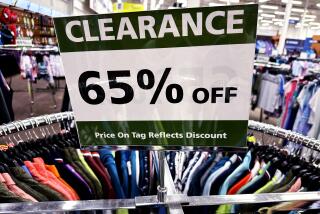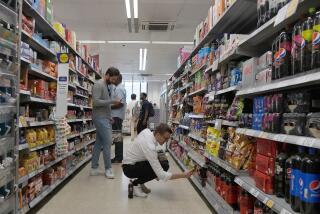Consumer price index jumps 0.4% in May as inflation heats up

Americans paid more for just about everything last month, pushing inflation to its highest annual rate in more than 11/2 years and creating another potential obstacle for the economic recovery.
The 0.4% jump in the consumer price index for May, released Tuesday by the Commerce Department, was the biggest since early last year.
Still, after years of slow price growth caused by the Great Recession, the 2.1% inflation rate for the 12 months that ended in May remains a little way from the level that would spur the Federal Reserve to increase rock-bottom interest rates.
------------
FOR THE RECORD:
Rising inflation: An article in the June 18 Business section about May’s 0.4% jump in the consumer price index said the Commerce Department released the data. The information was released by the Labor Department.
------------
In fact, economists said a return to a more normal inflation rate would be a positive development if it were driven by wealthier workers opening their wallets more frequently.
Instead, however, average wages have fallen over the last year after higher prices were taken into account. And the recent surge in the consumer price index was caused largely by rising prices for two crucial staples — food and gasoline — that will hurt Americans’ finances and the broader economy.
“Consumers are not going to be very happy when they stop at the gas station on the way to the grocery store,” said Michael Montgomery, an economist at IHS Global Insight. “They are hyper-sensitive to food and gasoline because those are the two prices in the economy that consumers see the most often.”
Food prices rose 0.7% in May, the biggest increase since August 2011, the Commerce Department said. Drought conditions in California and elsewhere, along with delayed planting after rough winter weather in much of the nation, combined to push up food costs.
Higher gas prices, triggered in part by the tensions between Russia and Ukraine, led energy costs to jump 0.9% last month.
The May report doesn’t take into account the recent fighting in Iraq, which has caused oil prices to jump this month. Those costs should start reaching gas pumps soon.
“There’s a lot of geopolitical noise out there that’s giving everybody a little bit of a pause,” said AT&T Inc. Chief Executive Randall Stephenson, chairman of the Business Roundtable.
In the trade group’s quarterly survey, also released Tuesday, top chief executives slightly downgraded their forecast for economic growth this year. Concerns about rising oil prices are causing caution, Stephenson said.
“I think all of us in the business community are a bit guarded as we look out over the second half of the year,” he said. “Oil prices have moved up.... That generally has a downward pressure on consumer spending.”
Some analysts have been warning for several years that the Fed’s easy-money policies would spark high inflation. Last month’s increase in the consumer price index, part of an upward trend in which the index rose 0.3% in April and 0.2% in March, led Peter Morici, a University of Maryland economist, to declare that the problem had arrived.
“This is enough that the Fed should sit up and pay attention,” he said.
Fed policymakers, at the conclusion of their two-day meeting Wednesday, are expected to say that they will continue reducing the central bank’s monthly bond-buying stimulus program as the economy improves.
At a news conference after the meeting, Fed Chairwoman Janet L. Yellen probably will be asked about the new inflation data and the timing of the Fed’s initial hike in its benchmark short-term interest rate, which has been kept near zero since late 2008 to try to boost economic growth.
Rate hikes are used to help keep inflation in check.
Yellen and other Fed policymakers have suggested that they could start raising rates in the middle of next year. But they’ve said the increases would be gradual as the economy continues to recover.
The Fed has wanted inflation to increase to its target of a 2% annual rate to avoid the problems of potential deflation — falling prices — that have been plaguing Europe. Rising prices help businesses increase hiring and wages, which boosts economic growth.
The annual inflation rate in the 28-nation Eurozone dropped to 0.5% last month from 0.7% in April as the region’s economy struggles to recover from a second lengthy recession after the 2007-09 crash.
Fed officials are unlikely to change monetary policy based on May’s consumer price index increase, said Diane Swonk, chief economist at Mesirow Financial. The Fed uses a different measure of inflation, which has been running at a lower annual rate. Its measure is based on personal consumption expenditures.
In April, the latest data available, the Fed’s inflation measure was 1.6% over the previous 12 months.
Fed policymakers have said they’d be willing to tolerate a higher annual inflation rate of about 2.5% if the labor market needed more stimulus, Swonk noted.
“If inflation was heating up because the economy was showing strength and wage gains, the Fed would welcome that and deal with it,” she said. “That’s not what’s happening.”
Job growth has been solid, averaging about 200,000 net new jobs per month over the last year, but not strong enough yet to push the Fed to increase interest rates. A key reason is that workers’ wages haven’t been keeping up with even the low inflation.
Real average hourly earnings, which take into account inflation, fell 0.2% in May from the previous month, the Labor Department said Tuesday. For the year that ended in May, those earnings were down 0.1%.
If wages don’t keep up, higher prices act like a tax increase on consumers, economists said.
The new data show there’s been “a dramatic deterioration in household purchasing power,” said Bernard Baumohl, chief global economist at the Economic Outlook Group.
Stripping out volatile food and energy costs, prices still were up 0.3% last month, the most since August 2011. The inflation rate for the prior 12-month period for those costs was 2%, the Commerce Department said.
Prices rose across the board in May, including airline fares, medical care, apparel, new vehicles and shelter, such as rent and hotel lodging.
“There was absolutely nothing in the report that would cheer up consumers,” Montgomery said.
“This is not the stuff of hyper- or even double-digit inflation, but it is draining and seemingly one thing after another,” he said.







